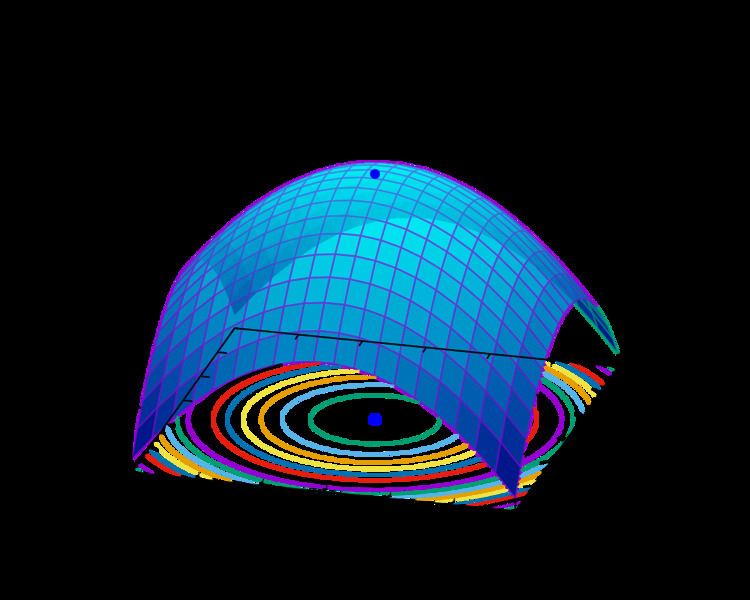 | ||
Limited-memory BFGS (L-BFGS or LM-BFGS) is an optimization algorithm in the family of quasi-Newton methods that approximates the Broyden–Fletcher–Goldfarb–Shanno (BFGS) algorithm using a limited amount of computer memory. It is a popular algorithm for parameter estimation in machine learning.
Contents
- Algorithm
- Applications
- Variants
- L BFGS B
- OWL QN
- O LBFGS
- Implementations
- Implementations of variants
- References
Like the original BFGS, L-BFGS uses an estimation to the inverse Hessian matrix to steer its search through variable space, but where BFGS stores a dense n×n approximation to the inverse Hessian (n being the number of variables in the problem), L-BFGS stores only a few vectors that represent the approximation implicitly. Due to its resulting linear memory requirement, the L-BFGS method is particularly well suited for optimization problems with a large number of variables. Instead of the inverse Hessian Hk, L-BFGS maintains a history of the past m updates of the position x and gradient ∇f(x), where generally the history size m can be small (often m<10). These updates are used to implicitly do operations requiring the Hk-vector product.
Algorithm
L-BFGS shares many features with other quasi-Newton algorithms, but is very different in how the matrix-vector multiplication for finding the search direction is carried out
We'll take as given
This formulation is valid whether we are minimizing or maximizing. Note that if we are minimizing, the search direction would be the negative of z (since z is "uphill"), and if we are maximizing,
Commonly, the inverse Hessian
This two loop update only works for the inverse Hessian. Approaches to implementing L-BFGS using the direct approximate Hessian
Applications
L-BFGS has been called "the algorithm of choice" for fitting log-linear (MaxEnt) models and conditional random fields with
Variants
Since BFGS (and hence L-BFGS) is designed to minimize smooth functions without constraints, the L-BFGS algorithm must be modified to handle functions that include non-differentiable components or constraints. A popular class of modifications are called active-set methods, based on the concept of the active set. The idea is that when restricted to a small neighborhood of the current iterate, the function and constraints can be simplified.
L-BFGS-B
The L-BFGS-B algorithm extends L-BFGS to handle simple box constraints (aka bound constraints) on variables; that is, constraints of the form li ≤ xi ≤ ui where li and ui are per-variable constant lower and upper bounds, respectively (for each xi, either or both bounds may be omitted). The method works by identifying fixed and free variables at every step (using a simple gradient method), and then using the L-BFGS method on the free variables only to get higher accuracy, and then repeating the process.
OWL-QN
Orthant-wise limited-memory quasi-Newton (OWL-QN) is an L-BFGS variant for fitting
where
O-LBFGS
Schraudolph et al. present an online approximation to both BFGS and L-BFGS. Similar to stochastic gradient descent, this can be used to reduce the computational complexity by evaluating the error function and gradient on a randomly drawn subset of the overall dataset in each iteration. It has been shown that O-LBFGS has a global almost sure convergence while the online approximation of BFGS (O-BFGS) is not necessarily convergent.
Implementations
An early, open source implementation of L-BFGS in Fortran exists in Netlib as a shar archive [1]. Multiple other open source implementations have been produced as translations of this Fortran code (e.g. java, and python via SciPy). Other implementations exist:
Implementations of variants
The L-BFGS-B variant also exists as ACM TOMS algorithm 778. In February 2011, some of the authors of the original L-BFGS-B code posted a major update (version 3.0).
A reference implementation is available in Fortran 77 (and with a Fortran 90 interface) at the author's website. This version, as well as older versions, has been converted to many other languages, including a Java wrapper for v3.0; Matlab interfaces for v3.0, v2.4, and v2.1; a C++ interface for v2.1; a Python interface for v3.0 as part of scipy.optimize.minimize; an OCaml interface for v2.1 and v3.0; version 2.3 has been converted to C by f2c and is available at this website; and R's optim general-purpose optimizer routine includes L-BFGS-B by using method="L-BFGS-B".
There exists a complete C++11 rewrite of the L-BFGS-B solver using Eigen3.
OWL-QN implementations are available in:
